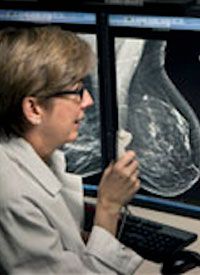3D Mammograms Improve Breast Cancer Detection, Reduce Callbacks
The benefits of 3D mammography are durable, increasing detection of breast cancers and reducing anxiety over callbacks, according to a recent study that provides the first longitudinal evidence of the utility of this approach.
3D Mammography

Credit: Penn Medicine
The benefits of 3D mammography are durable, increasing detection of breast cancers and reducing anxiety over callbacks, according to a recent study that provides the first longitudinal evidence of the utility of this approach.
“Patients are very excited about this because nobody likes to come back unnecessarily for additional imaging,” explained Sally Friedewald, MD, in an interview. Friedewald, an assistant professor in radiology at Northwestern Medicine in Chicago, led a 2014 study demonstrating the benefits of 3D mammography over a span of 1 year.
This new study, which was conducted over 3 years by researchers at the Perelman School of Medicine at the University of Pennsylvania, including the study’s senior author, Emily F. Conant, MD, suggests that the benefits of 3D mammography, also known as digital breast tomosynthesis (DBT), increase as time goes on. The study showed that the number of unnecessary callbacks went down, whereas the percentage of cancer detection increased.
Conant, who is chief of breast imaging in the Department of Radiology at Perelman, and colleagues analyzed 44,468 screening mammography examinations performed at Penn’s Perelman Center for Advanced Medicine from 23,958 women who had no history or clinical history of breast cancer.
All screenings took place during the period September 2010 to August 2011, in which women received digital mammography (DM) only, and then over 3 consecutive years after the practice converted from DM to all DBT. Researchers compared differences in screening outcomes between each DBT year and the DM baseline year as well as between groups of women with a history of only one, two, or three DBT screenings.
Recall rates increased slightly in years 1, 2, and 3, at 88, 90, and 92 per 1000 screened, respectively, but remained significantly reduced from the rate of 104 per 1000 in the DM-only group.
Cancer cases detected in recalled patients rose from 4.4% in DM alone, to 6.2%, 6.5%, and 6.7% in years 1, 2, and 3 of DBT screening, respectively. Additionally, outcomes for the most recent screening for individual women undergoing one, two, or three DBT screenings showed decreasing recall rates of 130, 78, and 59 per 1000 patients screened, respectively. So-called “interval cancer” rates decreased slightly from 0.7 per 100 women screened with DM to 0.5 per 1000 screened with DBT. “One of the main criticisms of mammography is that there are a lot of false positives. The 3D mammogram really addresses that main concern,” Friedewald said. “We’re picking up more cancers too—the invasive cancers, the cancers we worry about,” she noted, adding that the 3D method is better able to see through the dense breast tissue than standard mammography. Also, once an abnormality is seen with the 3D image, clinicians have a better idea of what it is and have fewer compounding questions.
There is at least one place in every state in the country that provides 3D mammography service, and Friedewald said that the numbers are growing, as the tests are reaching out to smaller community care centers in less populated areas. While Medicare covers the cost of 3D mammography, most other insurance companies are apprehensive about reimbursing for them because no longer-term studies have been able to definitely prove that this procedure could be lifesaving.
“There are no long-term outcomes that we can say, ‘Yes, this saves lives.’ We think it likely will, but we have to wait 20 or 30 years before we have those numbers,” Friedewald says. “We’re hoping that these data will then help improve insurance coverage because this will be a huge help for women.”
“My feeling is that this will be the standard of care within the next five years,” she said.
McDonald ES, Oustimov A, Weinstein SP, et al. Effectiveness of digital breast tomosynthesis compared with digital mammography: outcomes analysis from 3 years of breast cancer screening [published online before print February 18, 2016]. JAMA Oncol.
Nurse Practitioners Weigh in on Data From the San Antonio Breast Cancer Symposium
January 16th 2023Loyda Braithwaite, MSN, RN, AGPCNP-BC, AOCNP; and Jamie Carroll, APRN, CNP, MSN, highlight presentations from the 2022 San Antonio Breast Cancer Symposium that will influence oncology nursing practice.


